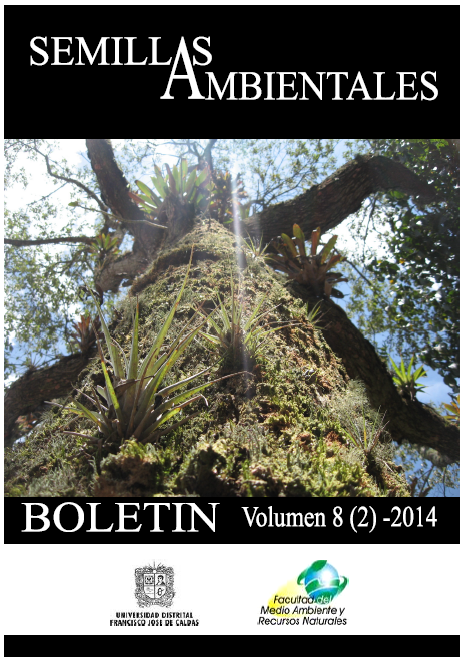Publicado:
2015-10-12Número:
Vol. 8 Núm. 2 (2014): Boletín Semillas AmbientalesSección:
Artículos científicosVALORACIÓN DEL ARBOLADO EN LA UNIVERSIDAD DISTRITAL FRANCISCO JOSÉ DE CALDAS (FAMARENA) CON TECNOLOGÍA FIELD-MAP
Descargas
Resumen (es)
Se viene realizando una valoración del arbolado urbano en la Universidad Distrital Francisco José de Caldas (FAMARENA) bajo un contexto económico, ambiental y social mediante la implementación de tecnología Field Map como instrumento para la recolección de datos representados en variables cuantitativas y cualitativas, además del posicionamiento espacial de los individuos en un sistema de información geográfica incluido en dicha tecnología, con la finalidad de obtener un panorama en términos económicos respecto al valor representativo de los arboles urbanos teniendo en cuenta los servicios ofrecidos por los individuos a nivel paisajístico, sanitario y demás beneficios en pro del bienestar humano y con ello establecer a futuro posibles métodos de manejo, control y establecimiento requeridos por el arbolado urbano.
Referencias
CODER, R. 1996. Identified benefits of comunnity trees and forests. University of Georgia, 7.
CONTATO,M.,AYUGA,E. & GRANDE,M.2008. A comparative analysis of methods for the evaluation of urban trees in Santiago del estero, Argentina.spanish journal of agricultural research.vol 6(3) pp:341-352
CORTÉS, Y. C. 2013. Aproximaciones a la Valoración Económica Ambiental para los Árboles Patrimoniales de Bogotá Aproximaciones a la Valoración Económica Ambiental para los Árboles Patrimoniales de Bogotá. Universidad Nacional de Colombia, 114.
COUNCIL OF TREE & LANDSCAPE APPRAISERS. 2000. Guide for Plant Appraisal (9th ed.). International Society of Arboriculture, Champaign, IL. 143PP
COUNCIL OF TREE & LANDSCAPE APPRAISERS. 2000. Guide for Plant Appraisal (9th ed.). International Society of Arboriculture, Champaign, IL. 143PP
DONOSO, M. P., & PIEDRAHITA, P. 2009. Valoración económica del arbolado urbano en 28 comunas de Chile, 17, 88–100.
DWYER, J. F., SCHROEDER, H. W., & GOBSTER, P. H. 1991. THE SIGNIFICANCE OF URBAN TREES AND FORESTS : TOWARD A DEEPER UNDERSTANDING OF VALUES. Journal of Arboriculture, 276–284.
FLOOK, R. 1996. A Standard Tree Evaluation Method. Royal New Zealand Institute of Horticulture. 75pp.
GRANDE, M AYUGA, E CONTATO, L. 2012. Methods of Tree Appraisal : A Review of Their Features and Application Possibilities. Arboriculture & Urban Forestry, 38(4), 130–140.
HASTIE,C.2003.The benefits of urban trees.warwick district council.p5
HERRUZO, C. 2002. Fundamentos y métodos para la valoración de bienes ambientales, 1–13.
JIM, C. Y., & CHEN, W. Y. 2009. Ecosystem services and valuation of urban forests in China. Cities, 26(4), 187–194. doi:10.1016/j.cities.2009.03.003
LOPEZ ,A.,LÓPEZ, R.,TREVIÑO, E.,JIMENEZ, J & ALANÍS, G.2013. Valoración del arbolado urbano utilizando el sofware i-tree,en paseo de los duendes, san pedro Garza Garcia,N.L. Universidad autonoma de nuevo Leon.pp:36-41
LOPERA, F. G. 2005. Las zonas verdes como factor de calidad de vida en las ciudades. CIUDAD Y TERRITORIO Estudios territoriales , 19.
MATTIOLI, W., ALIVERNINI, A., DI PAOLO, S., PORTOGHESI, L., GIULIARELLI, D. 2009. Field-Map: uno strumento innovativo al servizio della selvicoltura. Atti 13a Conferenza Nazionale ASITA, 1 – 4
MCPHERSON, E. G. 2007. Benefit-Based Tree Valuation, 33(January), 1–11.
MORENO, J. 2004. utilizacion del metodo del costo de viaje para la valoracion economica de los parques recreativos caso practico:Valoracion del parque forestal recreativo "Puente sopó". Colombia Forestal, 161-179.
NOWAK, D. J., CRANE, D. E., & DWYER, J. F. 2002. Compensatory Value of Urban Trees in the United States. Journal Of Arboriculture, 28(4), 194–199. Retrieved from http://treelink.org/joa/2002/july/05Nowak.pdf
OCHOA, J. M. 2009. Ciudad,vegetacion e impacto climatico. Barcelona: Erasmus ediciones.
OTAYA, L, SÁNHEZ, R., MORALES, L., & BOTERO, V. 2006. LOS SISTEMAS DE INFORMACIÓN GEOGRÁFICA (SIG), UNA GRAN HERRAMIENTA PARA LA SILVICULTURA URBANA. Revista Facultad Nacional de Agronomía, Medellín, 59(1), 3201-3216. Recuperado en 11 de septiembre de 2014, de http://www.scielo.org.co/scielo.php?script=sci_arttext&pid=S0304-28472006000100008&lng=es&tlng=es
PECKHAM, S. C., DUINKER, P. N., & ORDÓÑEZ, C. 2013. Urban forest values in Canada: Views of citizens in Calgary and Halifax. Urban Forestry & Urban Greening, 12(2), 154–162. doi:10.1016/j.ufug.2013.01.001
PETERSON, K. S., & STRAKA, T. J. 2011. Specialized Discounted Cash Flow Analysis Formulas for Valuation of Benefits and Costs of Urban Trees and Forests, 37(5), 200–206.
PONCE, MAURICIO VALLEJOS, Ó., & DANILUK, GUSTAVO AVILÉS, C. 2013. Comparación de siete fórmulas chilenas para la valoración del arbolado urbano. Agrociencia, 47, 723–737.
PRICE, C. 1999. Quantifying the aesthetic benefits of urban forestry. Urban Forestry & Urban Greening, 123–133.
ROY, S., BYRNE, J., & PICKERING, C. 2012. A systematic quantitative review of urban tree benefits, costs, and assessment methods across cities in different climatic zones. Urban Forestry & Urban Greening, 11(4), 351–363. doi:10.1016/j.ufug.2012.06.006
SARAJEVS, V. 2011. Street Tree Valuation Systems . Forestry Commision, 6.
WATSON, G. 2002.COMPARING FORMULA METHODS OF TREE, 28(January), 11–18.
WOLF,K.1998Trees in Business Districts - Positive Effects on Consumer Behaviour,
University of Washington College of Forest Resources, Factsheet #30.
WU, D. 2008. Forest Health Comparison of City Park and Stephen F. Austin State University Campus Trees, Nacogdoches, Texas. ProQuest. 71




